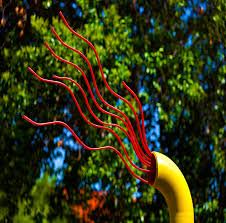By Bart Barry-

Editor’s note: For part 13, please click here.
SAN ANTONIO – Thursday evening in this city’s irreplaceable McNay Art Museum, as part of its quarterly series Artists Looking at Art, local sculptor James Hetherington conversed with the museum’s chief curator about what relationships are shared by the materials he uses and their discovery and the works they eventually compose. Series of reactions he catalyzes that often form tributes to the originators of their component parts, Hetherington’s sculptures are large and enormously heavy and assembled from pieces he recovers from a local salvage yard. They form among many things Hetherington’s contribution to an ecological conversation about sustaining our world by repurposing materials.
What Hetherington is after does correlate in its way with boxing (for once).
Somewhere in his language of sustainability, an idea whose cliche is not lessened by the fullness of its artist’s belief, is the idea of taking parts as life presents them and relating them to one another oftener with a welding torch than a saw and prizing the sum of their reactions followed by their new collective’s reactions to the elements of their spaces.
When his thoughts were interrupted by questions about the colors he uses Hetherington confirmed with diminishing enthusiasm the colors of his sculptures come via oxidation much as intention. The artist’s vision for his work is its initial condition and what follows is iterative; the pieces he scavenges in junkyards and fits together and the effects then taken on them by wind and rain and sunlight, elements taking their effects meanwhile and too on those who view the sculptures, harmonize (cooperate) with and alter (compete with) the pieces in a process whose varying results are, like every other experience, equal parts impossible and inevitable.
In this sense Hetherington plays an exceptional boxing trainer much more than a fighter or a middling trainer. Our beloved sport bursts with middling trainers – men who endeavor to carve or melt younger men into proven or at least popular fighting styles and shapes without very much regard for these men’s natural endowments or deference either to nature. Even exceptional trainers rarely prove to be ponies with more than one trick but at least they have that trick, and with promotional-television revenues involved, one trick a multimillionaire can make.
Emanuel Steward was very good at teaching tall men to dominate with straight punches. Freddie Roach is quite good at helping athletic punchers maintain their balance while increasing aggression. But Roach would prove no better at improving Wladimir Klitschko – whose post-Steward dominance of opponents remains proportionate to the number of inches he towers over them – than Steward proved at improving Miguel Cotto.
If the best trainers, then, work to harmonize the materials they’re given within the hard if not narrow boundaries imposed by a sport in which death is possible and permanent damage is assured, a new question arises: How essential are exceptional trainers?
Their essentiality generally relates to the experience of the men they train. While Floyd Mayweather Sr. and Nacho Beristain, both, were perfectly essential in the developmental stages of their respective prodigies, Little Floyd and Juan Manuel Marquez, neither has provided more than comfort and familiarity in his charge’s most recent matches. Maybe even Abel Sanchez once was essential to the development of Olympic silver-medalist Gennady Golovkin after Golovkin was already good enough to win a silver medal without him, but with the competition K2HBO now feeds him, Golovkin could score a knockout with an actual pony in his corner.
This may not be an important question as it relates to contemporary art but it remains an interesting and frequent one since Andy Warhol elevated tracing others’ works, whether labels or photographs, to something critics credited with approximating originality. It’s a question that made James Hetherington a touch sheepish Thursday night too. While he properly believes his talent for vision and scavenging and attachment makes him an artist and his productions art, Hetherington is aware consensus among the commonfolk at times can be shaky.
The laity reliably appraises fine art, as opposed to fashion art, by asking: Could I do this? If the answer is yes the art is fashion and if the answer is no a piece requires secondlooking. Yes, but. Like most who enjoy reduction – pursuing the known, not the unknown – these earnest folks who would doubt a curator that included commonly doable things in an exhibition (still preferable company to what art-school airheads relentlessly shout “a-mazing!” at their classmates’ collaborative doodles) must move the variable t before they reject what they see once it exists.
This seemed to be Hetherington’s slightly defensive rebuttal when he reported he sees all these works in his mind before he finds their parts. That is his art (where welding and pipefitting get regarded as trades and crafts). There’s a reason, Hetherington properly insists, no one else in the neighborhood meanders in the same junkyard then scores commissions to erect his works in public spaces no matter how obvious these creations later appear in their finished states.
It’s a skill, a science even, to reduce works of complexity to their component parts; it’s an art to snatch from the inconstant pulses of one’s own mind a set of shapes and materials to recover and conjoin and ultimately present to the eyes of other impossibly complex beings whose own inconstant minds pulse ever rabidly about. The most Hetherington or any creator can do is drop his works in the universe of feedback loops and hope for the best.
Bart Barry can be reached via Twitter @bartbarry











